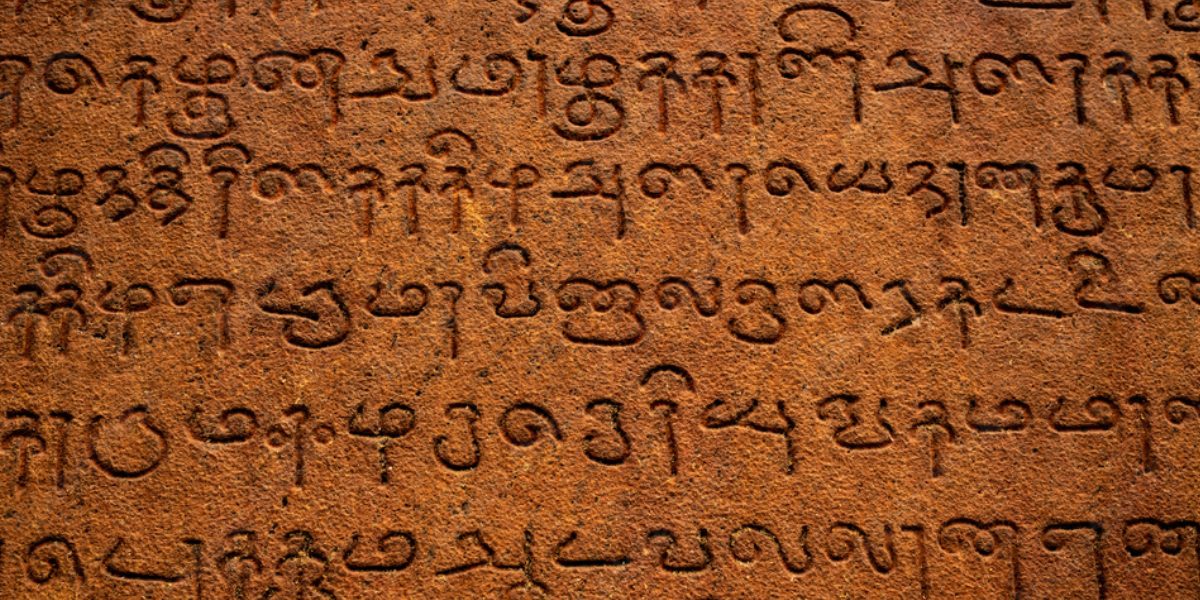In recent years, the thought of 'native' is everywhere and corporates are incorporating them in their products to sell them in Tamil Nadu.

Ancient Tamil language xcript. (iStock)
After Independence, when the whole of India was learning English and Hindi apart from their regional language, Tamilians gave more attention to English. The emphasis was so much on English that Tamil, which had a rich history, had to take a back seat.
English became the medium of education in the majority of schools. Knowledge of Tamil literature and grammar started diminishing. People conveniently opted to omit Tamil as their second language in schools and preferred another language that would get them more marks.
A group of Tamilians who did not know how to read and write Tamil started growing in society. The need to run in the global race and come up financially did not give them time to realise the richness of their language.
However, the pride in calling themselves “Nan Tamizhan da” (I am a Tamilian) alone was always there. Maybe the politicians kept this feeling alive. The belief of English as a knowledge is more common among the Tamilians than others. But to an extent, this belief did help them to be placed in high positions across the globe.
Once Tamilians got well placed financially after globalisation, they started thinking about their roots. As they interacted with the rest of the world, they noticed how communities with lesser heritage proudly portrayed their history. They realised the need to know and publicise their history.
This kind of mindset was in its nascent stage during the mass “pro-Jallikattu movement” in the year 2017. This movement literally accelerated the thought of searching for our roots. It is an important milestone for Tamil because it made its young crowd return to it. People not only searched for information about native breads but also about anything that was native.
Big brands faced massive falls due to this sudden awareness of “native” thought. This was when most Tamilians understood their culture was rich in history and intrigue. This realisation was among all the Tamilians irrespective of their castes or other social and political factors. This was one major movement that united them as Tamilians, and it seeded the need to protect and safeguard their rich literature and culture.
In the past seven years, the thought of native is everywhere, and corporates have also started incorporating them into their products to sell them in Tamil Nadu. The word “native” has become a magical word to convince a consumer.
The pandemic in the year 2020, which made everyone across the globe slow down their fast lifestyle and thinking, further nurtured the “search for roots” outlook among Tamilians. The “pride and search for roots” mentality is now at its peak.
Any politician’s dream would be to convince and get the support of the people. Like how corporates use the magical word “native”, politicians are now forced to come up with policies that would talk about the promotion of the rich Tamil culture. Just slogans on Tamil are insufficient to satisfy the current, proud, educated Tamil voter. A proper, convincing plan needs to be shown. The present Tamil Nadu government has very well sensed the mindset of its people. I think it is the first time I have seen a financial budget talking so much about Tamil literature and heritage. From another angle, for a Government, this is an easy and quick way to convince the Tamil crowd emotionally.
Ancient Tamil literary works are knowledge banks of early Tamil life. Epic Silappathikaram talks so elaborately about the social life of citizens in the early Chola, Pandya and Chera Tamil country, which is why it is called Kudimakkal Kappiyam, meaning epic about the citizens. It is a treasure trove of information relating to ancient Tamil music and art.
The same applies to the epic Manimegalai, which is a continuation of Silappathikaram; rich information packed in the lines of these twin texts needs to be known to the rest of the world. So, allocating funds to translate these two into other Indian and foreign languages needs to be welcomed wholeheartedly.
Allocation of funds to increase the digitisation of rare Tamil books would be an excellent opportunity for Tamils worldwide to benefit. News about the findings in archaeological excavations, which each time keep proving the antiquity of the Tamil language, is always well received with a feeling of pride. So, allocations in this sector may excite people, thinking they may hear more such news in the future.
The search for ancient Tamil agricultural practices, cultural traditions and food habits that arose from the pro-Jallikattu movement and fear of the pandemic are also nurtured in this budget. This budget satisfies the “pride and search for roots” mentality of current Tamilians.
Seeing a financial budget talking so much about our language is happy. At the same time, it would be nice if the government could consider developing a simplified form of ancient Tamil literary works to cater to young children. This could help create an interest in our ancient Tamil works.
Likewise, the government can also work on coming up with “Ainthinai Parks”, which demonstrate the various landscapes categorised by Tamil literature. These kinds of visual thematic museums or parks on ancient Tamil culture will help people to see nuggets of information in ancient Tamil culture through a different lens.
(The author is a Tamil historian who writes on the socio-cultural and religious practices of ancient Tamil Nadu. Views are personal.)

Jul 26, 2024

Jul 25, 2024

Jul 21, 2024

Jul 21, 2024

Jul 21, 2024

Jul 21, 2024